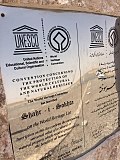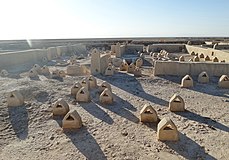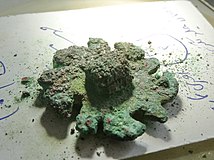被焚之城
| 世界遗产 | |
|---|---|
 被焚之城 | |
| 官方名稱 | Shahr-i Sokhta(英文) Shahr-i-Sokhta(法文) |
| 位置 | |
| 標準 | 文 (ii) (iii) (iv) |
| 参考编码 | 1456 |
| 登录年份 | 2014(第38屆會議) |
| 面积 | 275公頃 |
| 網站 | UNESCO的记录(英文) |
| 坐標 | 30°35′38″N 61°19′40″E / 30.59389°N 61.32778°E |
被焚之城(波斯語:شهرسوخته),意思是「被燒毀的城市」,為一處青銅時代人類定居點的考古遺址,位於伊朗東部錫斯坦-俾路支斯坦省,靠近阿富汗邊界附近。被焚之城在2014年6月被列入聯合國教科文組織《世界遺產》名錄[1]。
概要
被焚之城為一處位於伊朗東部的錫斯坦-俾路支斯坦省的考古遺址,在伊朗靠近阿富汗邊界旁,赫爾曼德河流域接近其終點哈姆湖(為一個內流湖)的附近。被焚之城及其文明有5千年歷史,估計此地最早約在西元前3200年成為人類居住地,考古學家發現了西元前1800年的遺跡[2]。
被焚之城是一處青銅時代遺址,其五個部分組成,包括中心區域、住宅區、工業區、歷史古跡與墓地[2]。遺址的西部是一個巨大的墓地,佔地25公頃。它包含25,000至40,000個古墓[3]。被焚之城在西元前1800年被廢棄之前,曾經被燒毀了3次[4]。
被焚之城有四個文明階段,各階段概述如下:
| 階段 | 年代 | 定居地規模 |
|---|---|---|
| I | 西元前3200~2800年 | 10~20公頃 |
| II | 西元前2800~2500年 | 45公頃 |
| III | 西元前2500~2300年 | 100公頃 |
| IV | 西元前2300~2100年 |
近代被焚之城是在1900年代初期,由英國考古學家馬爾克·奧萊爾·斯坦因發現和調查[5][6]。
1967年起,由毛里齊奧·托西(Maurizio Tosi)領導的義大利非洲與東方研究所(義大利語:Istituto Italiano per l'Africa e l'Oriente)考古團隊在遺址進行挖掘,這項工作一直持續到1978年[7]。後續由伊朗文化遺產和旅遊組織團隊接手[8],後續的年份持續有文物被發現[9]。
在文化意義上,阿富汗西部的赫爾曼德文明(Helmand Culture)年代約為西元前3世紀,學者認為其和被焚之城有關聯。赫爾曼德文明在西元前2500年至1900年間繁盛,並與印度河谷文明的繁榮時期相吻合,其年代對應被焚之城的第三和第四階段[10]。
被焚之城代表5千年前的青銅時代人類在該地區具備高度的文明。在遺址中發現有樓梯的房屋、紡織、木材加工、鑲嵌、大理石加工、漁網編織、陶器、坐墊編織和金屬工具製造、供水系統、廢水排放系統,以及第一次腦部手術、世界上第一個義眼、第一個動畫概念[2]。
特色出土文物

世界第一個義眼
2006年12月,考古學家在被焚之城發現了世界上最早的義眼(人造眼球),它的形狀為半球形,直徑剛好超過2.5公分(1英寸),重量相當輕,材質可能是柏油的填充物。義眼的表面覆蓋著一層薄薄的黃金,上面刻有一個中心圓(代表虹膜)和像太陽光線一樣圖案的金線。考古學家在一個墳墓中發現骨骸,是一位女性,發現時義眼在骷髏頭的左眼位置,由骨骸估計該位女性的身高為182公分(6英尺),比當時的普通女性高得多。在義眼的兩側都鑽有小孔,金線可以將小孔固定在眼球的適當位置。觀察骨骸的眼窩上有明顯的金線烙印,因此義眼是在其生前配戴過的。以這位女性的骨骸推算年代,約為西元前2900年至2800年之間[11]。
世界第一個動畫概念
被焚之城出土的一個陶器,上面描繪著數個分解動作,考古學家認為這是世界第一個展示動畫概念的案例[12]。
其他
圖集
登録過程
登錄基準
该世界遗产被认为满足世界遺產登錄基準中的以下基準而予以登錄:
- (ii)在某期间或某种文化圈里对建筑、技术、纪念性艺术、城镇规划、景观设计之发展有巨大影响,促进人类价值的交流。
- (iii)呈现有关现存或者已经消失的文化传统、文明的独特或稀有之证据。
- (iv)关于呈现人类历史重要阶段的建筑类型,或者建筑及技术的组合,或者景观上的卓越典范。[15]
參考文獻
- ^ 1.0 1.1 Twenty six new properties added to World Heritage List at Doha meeting. 聯合國教科文組織. 2014-06-25 [2020-03-02]. (原始内容存档于2019-11-22) (英语).
- ^ 2.0 2.1 2.2 被焚之城. 伊朗文化遺產、手工藝品和旅遊組織部. 2014-06-25 [2020-03-02]. (原始内容存档于2020-03-02) (中文(中国大陆)).
- ^ Sandro Salvatori And Massimo Vidale, Shahr-I Sokhta 1975-1978: Central Quarters Excavations: Preliminary Report, Istituto italiano per l'Africa e l'Oriente, 1997, ISBN 978-88-6323-145-8
- ^ Shahr-e Sukhte, A World Heritage Site at South East Iran. Destination Iran Tours. [2020-03-02]. (原始内容存档于2020-03-02) (英语).
- ^ Aurel Stein, Innermost Asia. Detailed Report of explorations in Central Asia, Kansu and Eastern Iran, Clarendon Press, 1928
- ^ Aurel Stein, An Archaeological Journey in Western Iran, The Geographical Journal, vol. 92, no. 4, pp. 313-342, 1938
- ^ Maurizio Tosi, Excavations at Shahr-i Sokhta. Preliminary Report on the Second Campaign, September–December 1968, East and West, vol. 19/3-4, pp. 283-386, 1969
- ^ S. M. S. Sajjadi et al., Excavations at Shahr-i Sokhta. First Preliminary Report on the Excavations of the Graveyard, 1997-2000, Iran, vol. 41, pp. 21-97, 2003
- ^ CHN - News. archive.org. 2012-03-13 [2018-04-07]. (原始内容存档于2012-03-13) (英语).
- ^ Jarrige, J.-F., Didier, A. & Quivron, G. (2011) Shahr-i Sokhta and the Chronology of the Indo-Iranian Borderlands. (页面存档备份,存于互联网档案馆) Paléorient 37 (2) : 7-34 academia.edu
- ^ 5,000-Year-Old Artificial Eye Found on Iran-Afghan Border. foxnews.com. 2007-02-20 [2018-04-07]. (原始内容存档于2013-05-20).
- ^ Foltz, Richard C. Iran in World History. Oxford University Press. 2016: 6 [2020-03-04]. ISBN 9780199335503. (原始内容存档于2019-06-29) (英语).
- ^ Unique marble cup, other discoveries in Burnt City. mehrnews.com. 2014-12-29 [2020-03-02]. (原始内容存档于2020-03-02) (英语).
- ^ Painted Leather Discovered in Iran’s Burnt City. Archaeology Magazine. 2015-01-13 [2020-03-05]. (原始内容存档于2015-06-11) (英语).
- ^ Shahr-i Sokhta. 聯合國教科文組織. [2020-03-02]. (原始内容存档于2020-01-24) (英语).
外部链接
- Burnt City Video, part 1 of 4 - Youtube(页面存档备份,存于互联网档案馆)
- Burnt City Video, part 2 of 4 - Youtube(页面存档备份,存于互联网档案馆)
- Burnt City Video, part 3 of 4 - Youtube(页面存档备份,存于互联网档案馆)
- Burnt City Video, part 4 of 4 - Youtube(页面存档备份,存于互联网档案馆)
| ||||||||||||||||||||
Text is available under the CC BY-SA 4.0 license; additional terms may apply.
Images, videos and audio are available under their respective licenses.










